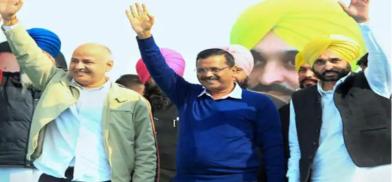Punjab election shows good governance does gets votes in India
It is a no-brainer that Arvind Kejriwal’s victory speech was sharply focused on issues of governance, writes Jagdish Rattanani for South Asia Monitor

One message of the BJP’s 4-1 victory in the recent assembly in India polls is that it can turn around a poor performance and anti-incumbency with aggressive campaigning laced with doses of communalism, like it did in Uttar Pradesh. But the bigger message comes from Punjab, where the spectacular victory of the Aam Aadmi Party (AAP) tells us that corruption, plain and simple, is a raging issue with the people of India. It may have gone out of focus, appeared to be side-lined by communal politics but draws votes the moment a credible, viable and organized alternative is presented with a clear campaign: to fight corruption and to offer good governance.
Lest we forget, this was the agenda on which Modi first won the national mandate: sab ka saath, sab ka vikas (with all, development for all). It is another matter that he and the BJP took everyone on a different ride. It is another matter that the ride still sells a good number of tickets, given the lack of or the lacklustre nature of the alternatives and the fatigue of falling back on the same old-timers who have often failed in the past.
Kejriwal agenda
It is therefore a no-brainer that Arvind Kejriwal’s victory speech was sharply focused on issues of governance. Why, for example, do Indian students go to Ukraine to study medicine, a fact that the nation learned in the aftermath of the crisis in that country? Why do schools not work as they should, why do hospitals turn away patients, why are public utilities so poorly maintained? These everyday questions of everyday people can still become turning points even though the election air has been driven by a hateful, communal edge.
The victory undoubtedly has huge implications for national politics headed into the next national elections in 2024, in the light of the expected completion of the Ram temple in Ayodhya, and will unleash its own dynamic that may pave the BJP’s pathway into the future.
But as the political power behind the throne of Delhi and Punjab states, Kejriwal will now have the credibility to play out his idea of governance, putting him on a better footing to spread to other states and build his party and candidature for bigger roles.
Sweeping win
The defeat in Punjab of biggies like former Chief Minister Amarinder Singh, who aligned with the BJP, the recently appointed Congress Chief Minister Charanjit Singh Channi (who stood from two seats and lost both), Shiromani Akali Dal (SAD) patron and former chief minister Parkash Singh Badal, who is 94 and lost an election for the first time in 50 years, SAD party chief and Badal’s son Sukhbir Singh Badal, senior SAD leader Bikram Majithia and others give the nature of the mandate for AAP.
There is merit in the view aired again post-election by the BJP that voters have rejected dynasty politics everywhere. In the 2017 polls in Punjab, for example, the Congress attempted to change faces with a “one family, one ticket” policy” but it saw more than half the new entrants as relatives of old-timers. This time, there is a range of fresh faces and an entirely different section at work, an example being mobile repairs shop owner Labh Singh Ugoke who defeated Chief Minister Channi or Jeevan Jyot Kaur, the sanitary pad activist who defeated Majithia and Navjot Singh Sidhu of the Congress.
The BJP has been quick to note that Kejriwal is no threat to its growth. But like it or not, the vote in Punjab is as much a vote against the incumbency of the Singh-led Congress government, which ruled for the most part of the term, as it is against the farm laws in a place where the protests were the most visible, significant and felt directly. The farm laws have now been directly linked to allegations of corruption which will not go away in a hurry, given the intensity of the protests, their length, the forced come back of the BJP, and the voices within the BJP, notably Meghalaya Governor Satya Pal Malik, raising many questions on legislation.
BJP has changed
It should be clear at this stage that the BJP under Prime Minister Narendra Modi has not earned itself the image of a clean party. There was a time of tussle between the so-called old-timers and the ‘pragmatists’, the latter represented by the likes of the late Pramod Mahajan who wanted to grab power, whatever the means or costs. What has eventually emerged is an entirely different and potent force that seeks to override, overwhelm and even obliterate the past, in an unprecedented kind of ‘Rumsfeldian’ shock-and-awe spread across the nation. US Defence Secretary Donald Rumsfeld used it against Iraq. The BJP uses it against India.
In the end, the BJP can hardly keep away from allegations of corruption. It needs more of the business connections to feed its pipeline, to do the ‘shock-and-awe’, and to carpet-bomb the nation with its propaganda. Its policies, like the new labour laws that will take effect now, will pit it against the ordinary people and particularly the poor. Its establishment status and the desire to perpetuate its power and to promote its communal agenda will lead to more strife. In the end, its corruption is as vulnerable to Kejriwal’s rhetoric and work as it has proved against the Congress.
So, in the reality of a 4-1 victory and a divisive politics sits the tale of a seismic change that carries some hope that governments in the future will run on issues of governance and not on issues of 'gaushala' (cowsheds).
(The author is a senior journalist and author. Views are personal. By special arrangement with The Billion Press)









Post a Comment